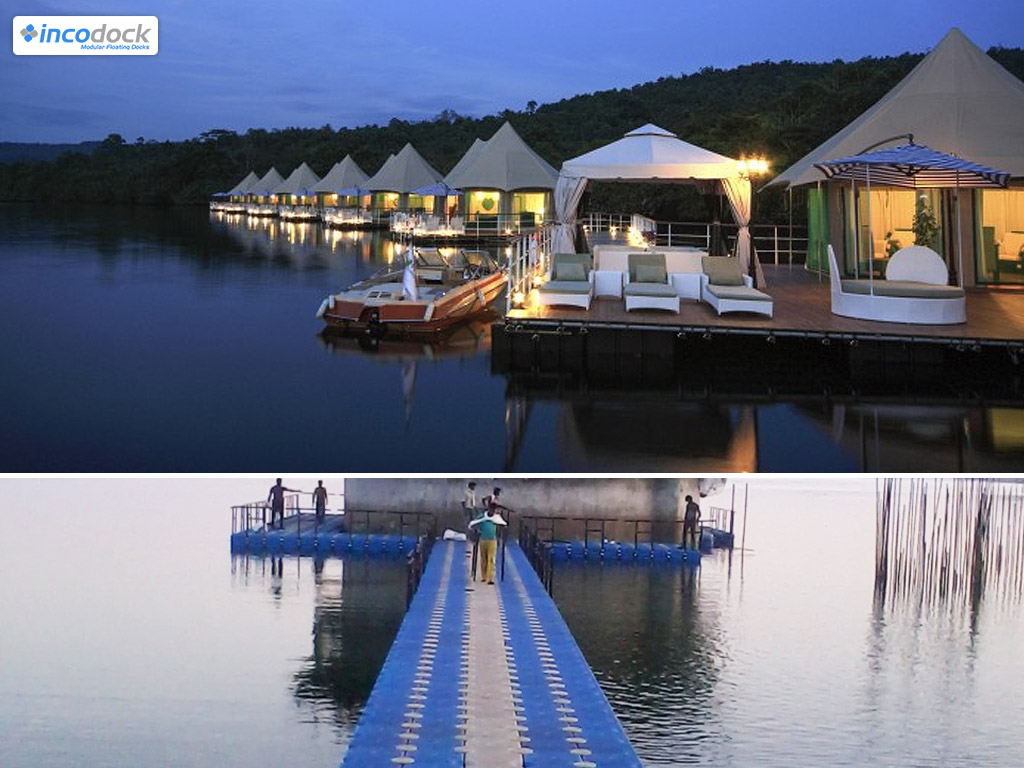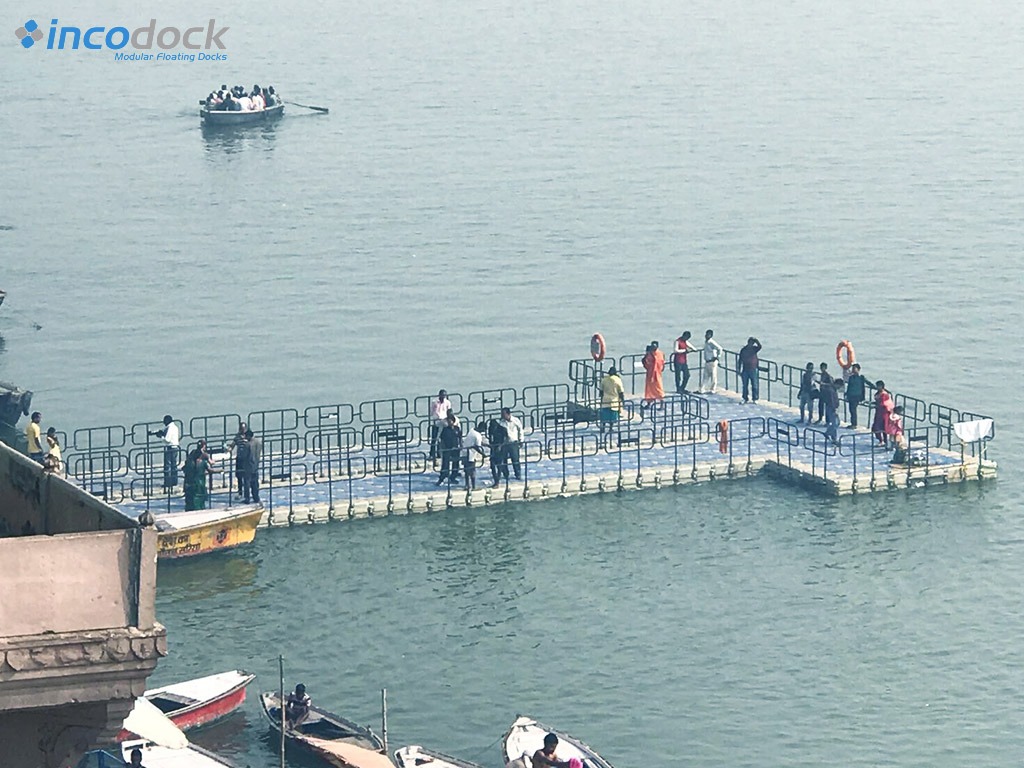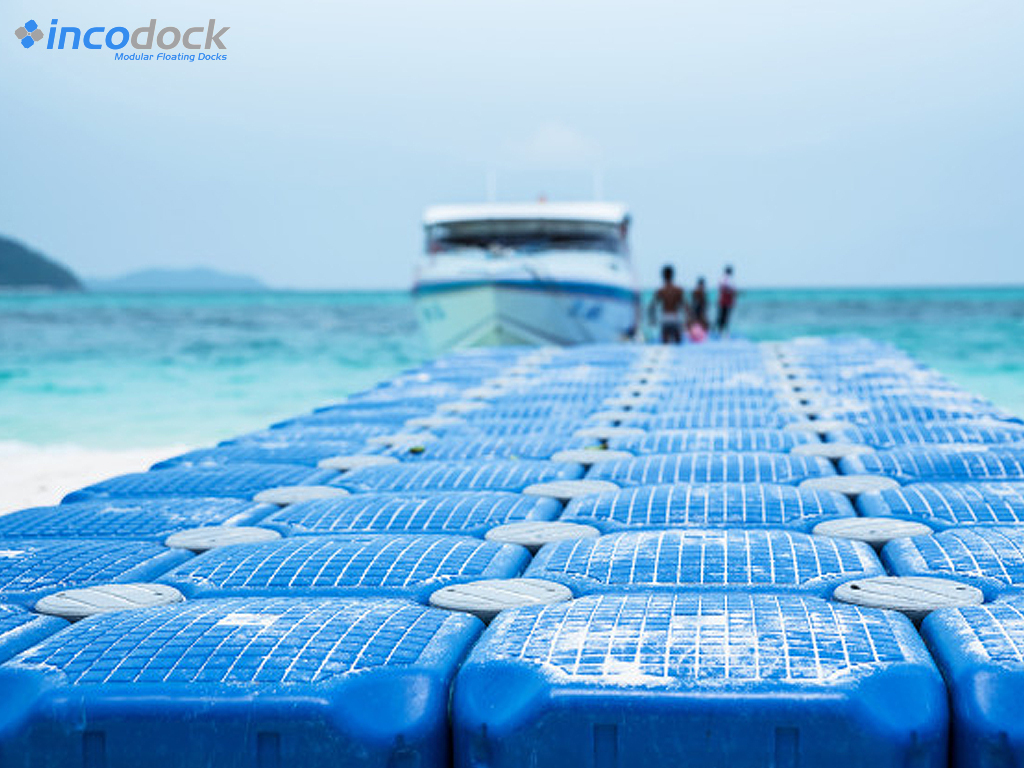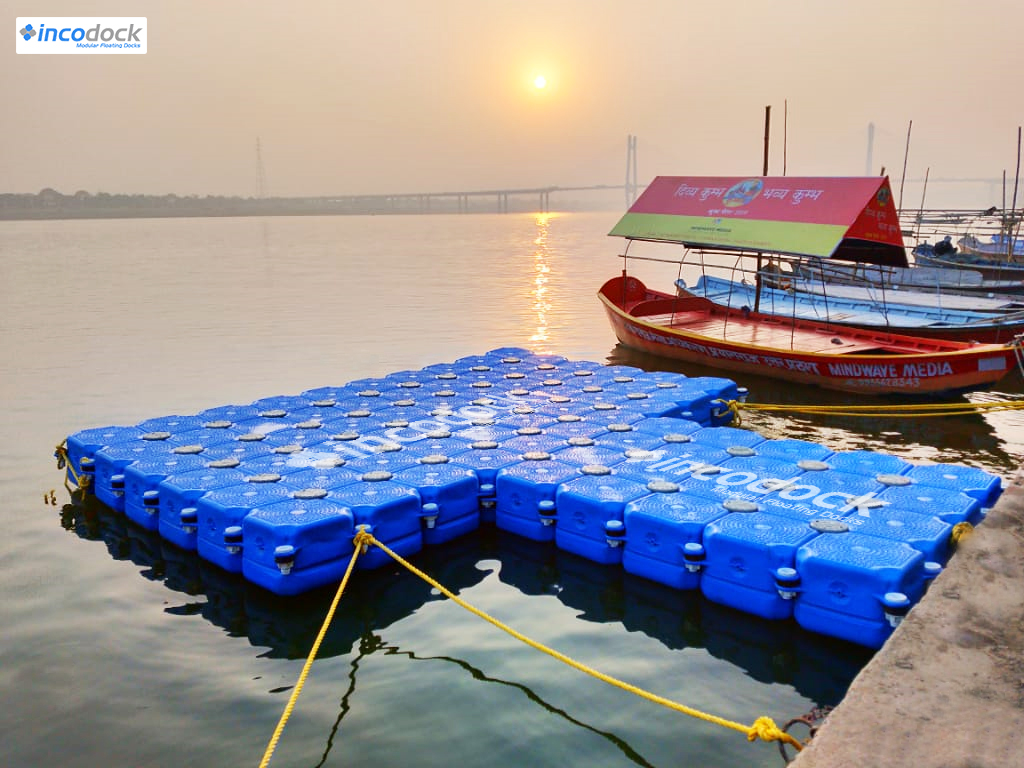Call us : +91 7738778000

Inhabitants around water bodies and coasts are used not only to the gorgeous scenery & an abundance of natural attractions but they also have to weather natural disasters like storms & hurricanes.
With more storms making landfall every year, knowing how to secure your floating dock system against them is essential & floating dock manufacturers in India provide necessary guidelines in light of the same.
In this guide, we’ll take you through the risks posed by such extreme weather phenomena to your floating dock systems & how you can ensure their safety.
Risks Posed by Natural Disasters To Floating Docks
Natural disasters like storms cause huge damage to both property & environment and for floating dock owners, lack of proper preparation for dock protection can mean all the difference between safeguarding their dock and having to reconcile potentially irreparable damages not only to the dock but also to the structures like pilings, walkway, bridges etc. associated with it.
Here are some of the risks such natural disasters pose to your dock system.
- If not secured properly, the storms can loosen floating dock units, change their orientation entirely rendering the dock useless, or even blow them away.
- Strong winds can rock the vessels anchored at the floating dock back & forth, causing potential damage to both the vessels as well as the dock surface.
- A storm/tornado can not only gather harmful debris around the dock, but the flying debris in it can badly damage the dock surface as well.
The severity of the disaster is directly proportional to the extent of damage one can expect in the worst-case scenario. By preparing for the worst, you can protect your floating dock, walkway, bridge, boats, kayaks or personal watercraft from imminent damage as much as possible.
Protecting Your Floating Dock System
Before the season of extreme weather arrives, you must take steps to ensure the safety of your floating dock.
Follow these 8 tips to secure your dock:
- Make proper installation of the floating dock a priority. Otherwise, you run the risk of the dock coming loose in strong winds. When selecting your docks, you can go for an organization like Incodock that gives recommendations for installation & also professional assistance.
- It is advisable to hire professionals for a thorough inspection of the dock, including the gangway, railings, couplers, bridges, walkways, & other fixtures. Patch up all vulnerabilities as per their recommendations & you can take pictures of the dock to compare its condition after the storm has passed.
- Consider adding dock bumpers to your floating dock in case there are others’ docks around yours. It will give you double benefit as it will protect your dock if something crashes into it and in case your own dock comes loose, the bumpers will protect others’ docks/properties as well.
- Pair your floating dock with an anchoring system (which can comprise stiff-arm brackets, adjustable piling brackets, deadweight brackets & winch inserts, mainframe piling hoops etc.) to enforce an extra level of security during violent winds & rains. Give some slack to the lines to account for high waves and increased surge. If possible, switch to spring lines as they afford superior shock absorption and maximum strength.
- Remove all unattached debris (paddles, storage containers, removable railings & lightings, signs etc.) & furniture from the dock so that they don’t become flying projectiles when the natural disaster strikes.
- Make sure the posttension or whaler cable system which tether the floating dock in place are in good shape. The cables are attached to the pilings below & allow the dock and bridge/walkway connected to it to ride the water surge.
- Always stay up-to-date on dock maintenance & dock preparation methods. Stay vigilant about changing weather conditions. If you are leaving town, make sure there is someone who can be relied upon to implement your emergency dock preparation.
- Inspect your dock system thoroughly after the disaster has passed. You can create a floating platform with Incodock cubes for surveying & inspecting any damage after the storm. Take stock of the damage and new vulnerabilities. If you own an Incodock, it is super easy to clean & repair it in very short time. Check for debris, snakes etc. that could have washed around your dock.
Incodock is an installer of modular floating docks, jetties and pontoons. We manage turnkey floating construction projects by providing consultation & expert advice along with installation & maintenance of floating jetties, docks, etc.
The Incodock floating cubes are made up of the finest Virgin HDPE granules that strictly meet JAS-ANZ ISO 9001-2008 standards. They have considerable resistances to natural calamities, can withstand temperatures up to 110°C and are recyclable, offering residual value even after their purpose is served.
Thinking about installing your floating dock? Feel free to contact us.
Read more about : Keeping Your Floating Dock Clean Throughout The Year

As the demand of floating docks in India is steadily growing among entities from diverse backgrounds, there are concerns about the safety aspects of floating dock systems. Also, in the eventuality of hazards like flash floods when the Monsoon is approaching the Indian subcontinent, cities prone to floods are worst hit.
During the floods, floating docks are at higher risk than fixed & recessed docks. Flash floods bring the destructive rage without warning and floating docks, if not properly secured, are sitting ducks in that catastrophic eventuality.
We at Inco believe that implementation of floating dock safety measures is of paramount importance. Our patron’s safety on the floating docks is our topmost priority & we manufacture the floating docks keeping the same in mind. Extending that concern, Inco brings to you 10 ways to identify & patch-up the seen or unseen dangers lurking on and around your floating dock.
10 Ways to Make Floating Docks Safe For Use
If you are an entity engaged in activities pertaining to water bodies, you will be definitely owning a dock. You would want to secure the dock not only to protect users of the floating dock but also to protect the business from legal action (and damage to its reputation) at the occurrence of any unfortunate incident on the dock. This is all the more pertinent when it comes to floating docks.
Even if you are private floating dock owner, you still need to implement proper safety measures for your guests, and the investment. Some of the safety steps are enumerated ahead.
-
Remove potential hazards : A very basic but potentially life-saving step. Remove all things that can cause tripping over the dock in the water. Ropes, tools, equipment etc. must not be found lying idly anywhere on the dock.
-
No-slip shoes : Docks are places that get wet all the time. Emphasize on your staff (or family members) to wear safe, non-slip shoes & encourage the customers/guests to do the same. It is always good to stock some anti-slip footwear if you own a dock.
-
Address the risk of fire : Electrical components & fuel points are common around docks. You know how fuel & fire go together, not at all a good combo for anyone at the dock! Always keep an extinguisher at hand. Ensure that electrical wiring is well insulated & electrical systems are operating within safety standards on the dock.
-
Ban swimming near dock : Floating dock is not a beach. It can be very dangerous if a frayed electric wire without proper insulation is dangling in the water and someone unknowingly decides to take the plunge. Also, boats may come and go near the dock. These boats often have power sources releasing charges into the water. Install signboards that warn the customers not to swim, wade or dive.
-
Keep an eye on the weather : You can use weather apps to keep a tab on the imminent weather and its possibility to change in few hours. Plan any event on the dock always keeping in mind the weather condition & keeping aware of any weather forecasts.
-
Proper positioning of docks : Keep the dock close to the shore. Simple. Anchors should be fixed downstream so that when the flooded river comes raging, the dock will pivot close to the shore thereby avoiding the rapid waters.
-
Staying within the safe distance : There is a limit on maximum distance from the shore within which you can be considered safe. Depending on the depth of the water body, limit of safe maximum distance can be decided to install the floating dock in such a way that it doesn’t pose obstruction in the way of water traffic.
-
Proper lighting : The dock should be well lit at night so that everyone is aware about the periphery of the dock and maintain safe distance. It will also serve as a marker to other boats and ships in water so as to maintain safe distance.
-
Rails : Safety rail all around the floating dock is a must and should be clearly visible (bright colors) to anyone on the dock.
-
Always keep few inflatable tubes & a first-aid kit on the dock : You never know what, & when, an emergency will suddenly manifest. You can’t be left searching for that stuff in a crisis.
As a floating pontoon manufacturer in India, Inco specializes in setting up floating jetties – known as Incodock – all over the country. An Incodock is manufactured from the finest Virgin HDPE granules that conform to stringent JAS-ANZ ISO 9001-2008 standards.
As mentioned at the start, Inco holds the safety of its patrons at the highest level of concern. We keep the modular design of the docks to enable not only their easy setup but also for fast dismantling in case a natural calamity is imminent or any other accident has occurred.
Incodock is highly customizable & has high tensile strength. Its resistant to chemicals & adverse effects of sea water ensures that your guests can enjoy on the dock without worrying about any rot in foundations of dock or any slippery algae. We have implemented slip-proof design on the surface of Incodock & smoothed the edges so that you are safe from any inadvertent mishap.
We ensure implementation of proper safety measures around the floating dock & also apprise the owners about same.
If you are interested to install a floating dock for your guests/ customers in a water body you own, we await you at Inco.
Read more about : Why Floating Docks are becoming more popular than Stationary, Elevated Docks

Anybody that’s been on a clean, scenic waterfront will vouch for the experience. When you’re on the edge of a dock or pier, legs dangling, wind flowing, sun setting, just water in front of you, you feel truly free. It’s a great feeling, one of the most pristine forms of escape from daily routine.
In addition to aesthetics, docks have all sorts of purposes. While it has traditionally been customary to build stationary docks, we see floating docking systems becoming more and more popular due to their versatility – especially easy to move & reconfigure modular solutions like Incodock’s systems comprising HDPE cubes.
Here, we compare stationary, elevated docks to modular, floating ones and their respective strengths and weaknesses
STATIONARY DOCKS:
These docks are built with a gap above the waterline to account for tides and fluctuations in water level. They are usually secured by steel pilings driven into the ground under the water body. Here are some of the aspects of stationary docks:
- Since this type of dock is fixed to the bed of the waterbody, it is very stable.
- Though boats are very secure at stationary docks, one has to be aware of the extra line needed to compensate for the fluctuating water level.
- Typically tend to hive a hire load bearing capacity than floating docks.
- Affords sturdy footing when getting into or out of moored boats or platforms due to lack of movement.
- In cases where the water level has high variance, at times there can be a pretty large gap to overcome. They’re better suited when water levels don’t deviate too much.
- There is a possibility of rodent or termite infestation in stationary docks due to the materials used.
- Stationary docks can become a safety hazard in dire situations like storms when the water level surpasses the height of dock.
- Over time, water deteriorates paint & - in case of wooden docks - rots the wood. Support poles of steel get corroded over time and since they are submerged, checking their condition and maintenance is difficult as well.
- Frequent maintenance is required to prolong the utility of these docks. Repairing the pilings deep under water is very expensive, more so when ice also plays a role.
All things considered, stationary docks will eventually splinter and warp over time, usually unknown to the owner. Conditions of the area, characteristics of the waterbody and quality of material used in construction all have to be keenly analyzed to get an accurate estimate of how long the installation will last before degradation sets in.
FLOATING DOCKS:
First introduced in the 90s, floating docks gained popularity due to their durability and configurability. Over time, floating pontoon manufacturers have constantly striven to improve, and floating solutions have developed by leaps and bounds. Today, the fact that even coast guards and naval establishments the world over prefer floating docks in their installations and during drills stands testament to their efficacy.
Some features that have helped raise the stock of floating docking systems:
- Ability to resize, realign & relocate. Modularity of cubes allows re-configuration of floating docks into different shapes and sizes as needs change. Assembly and disassembly doesn’t take long, and you can quickly change the shape of the entire platform or pack-up and install it at some other site.
- The buoyancy and ability to float on water surfaces – while being able to bear considerable weight – makes them usable on both stable as well as fluctuating water levels (owing to tides, seasonal variations or floods). This makes them highly reliable for a variety of sites.
- Made of high-density & recyclable polyethylene, these docks are virtually maintenance free. Even if maintenance is needed on rare occassion, it is very easy to carry out owing to the modularity of the docks.
- Adaptable – you can add and remove its sections irrespective of the season & change its shape to accommodate your need which makes it easy for you to hop on and off your watercrafts irrespective of water level.
- These docks are resistant to UV rays, snow, rain and can be affixed to any existing structure. They have high tolerance against adverse weather & come with long guarantees.
- The top surfaces of the floating jetty cubes contain special grooves to enhance grip. Dock cubes have highly reliable anti-skid design. You can safely park you jet skis on a floating pontoon dry-dock by attaching it to the dock cleats provided.
- A very long lifespan (commonly over a decade) of these floating jetties without wear and tear, & their versatile usage make them worth investing in over a long term.
- Floating jetty manufacturers also pay attention to aesthetics of the dock sections. It ensures that the platform you need for a party or docking your boats, looks appealing.
- Diverse uses: floating pontoons/docks/marinas, floating cottages, floating bridges/walkways, view stands for hotels, floating cafes/restaurants etc.
Floating docks are the better option in many use cases as compared to stationary docks. When extremely heavy loads have to be carried to and fro, fixed docks are usually the clear winner. Stationary docks are good for consistent water level sites whereas floating docks are independent of variations in water levels.
Inco Mechel, a floating jetty manufacturer in India, specializes in setting up floating jetties and pontoons all over the country. Manufactured from the finest virgin HDPE granules, our floating jetties, known as ‘Incodock’, conform to stringent JAS-ANZ ISO 9001-2008 standards and have made the older concept of interlocking walled floats redundant.
Incodocks are modular in nature making them very customizable in terms of size and shape. They can be setup in little time and are easily transportable – a 100 square meter Incodock can be installed within 2 hours. Also, it can easily be dismantled and reassembled making them reusable in case modifications are required.
Some of the other features of Incodock are:
- High impact resistance
- High tensile strength
- Chemical & corrosion resistant
- Temperature tolerance up to 110oC
- Moisture repelling
- Non-toxic & eco-friendly
- Very lightweight
Interested to set up your new floating boat dock or a floating pontoon?
We’ll be glad to collaborate with you on new designs and help you develop your idea of a floating platform based on your requirement. Let’s setup your waterfront with the right dock.
We are waiting to hear from you here.
Read more about : Floating Dock Safety Tips

A floating boat dock is an excellent way to secure your boat when it’s not in use. It is the perfect mooring system for your boat, where the floating raft-like construction is fastened with stretchy cables to the pilings on the sea floor. This article will enumerate the benefits of owning a floating dock.
-
Floating docks are buoyant and flexible –in comparison with stationary boat docks. Consequently, this helps the floating boat dock to ride the waves with your boat better than the stationary ones. In a storm, a boat tends to get tossed around a stationary dock; it may slam into the dock causing immense damage to your boat, to the dock or to both. You can circumvent this problem by owning a floating dock. The elasticity of the floating dock also exerts lesser stress on your lines and cleats.
-
Stepping on and off a floating boat dock is so much more convenient – this is due to the fact that the distance between the boat and the dock stay about the same, despite varying water levels.
-
A floating dock does not go under water during a storm - a stationary dock tends to sink during a storm, tearing off decking and giving rise to under water debris which is known to harm the hull and outdrive, as well as trigger other problems.
-
It makes complete sense to own a floating docks if your location experiences major vertical water movement – a floating boat dock will ride up and down with the changes in the level of the water. In fact, they are strongly advocated by the navy and coast guard in hurricane-bound areas.
-
Easy to install and very reasonable - the basic floating docks are delivered fully assembled, whilst, others can be assembled easily. Installing a basic floating dock does not call for the proficiency of a marine contractor or the use of speciality equipment; thus, setting up a floating boat dock is usually not at all expensive.
-
Easy Maintenance - floating boat docks are made from rather low-maintenance materials, such as polyethylene. You can install it and use it right away. It is also very easy to clean.
-
Floating Docks are Modular - Modular floating docks can be easily expanded and are sold in sections. By making use of connectors, sections of the dock can be put together like building blocks allowing you to configure and reconfigure the floating boat dock.
-
Trouble-free Removal - don’t fret about your floating dock getting damaged during a storm or hurricane. Floating docks can be removed effortlessly from the water and placed in a safe storage area.
We offer you excellent quality modular floating docks which are flexible, easy to install, reliable and long-lasting. We fashion custom designs which will optimally suit your requirements. Our floating docks allow you to securely moor all types of boats and watercrafts. Our docks and platforms are flexible and can be set up and configured in any shape you want. We also proffer a wide array of accessories to make your boat dock the best dock for leisure and commercial use. Our system helps you to create your own design to fit your personal preferences and our proficient consultants and engineers will help you install your floating dock efficiently and well.





